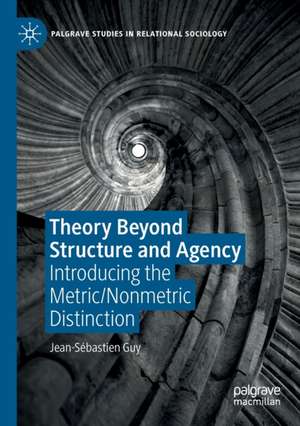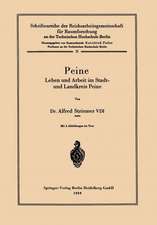Theory Beyond Structure and Agency: Introducing the Metric/Nonmetric Distinction: Palgrave Studies in Relational Sociology
Autor Jean-Sébastien Guyen Limba Engleză Paperback – 20 sep 2020
| Toate formatele și edițiile | Preț | Express |
|---|---|---|
| Paperback (1) | 385.25 lei 6-8 săpt. | |
| Springer International Publishing – 20 sep 2020 | 385.25 lei 6-8 săpt. | |
| Hardback (1) | 502.22 lei 6-8 săpt. | |
| Springer International Publishing – 20 sep 2019 | 502.22 lei 6-8 săpt. |
Preț: 385.25 lei
Nou
Puncte Express: 578
Preț estimativ în valută:
73.72€ • 76.50$ • 61.62£
73.72€ • 76.50$ • 61.62£
Carte tipărită la comandă
Livrare economică 18 martie-01 aprilie
Preluare comenzi: 021 569.72.76
Specificații
ISBN-13: 9783030189853
ISBN-10: 3030189856
Pagini: 277
Ilustrații: XIII, 277 p. 6 illus.
Dimensiuni: 148 x 210 mm
Greutate: 0.35 kg
Ediția:1st ed. 2019
Editura: Springer International Publishing
Colecția Palgrave Macmillan
Seria Palgrave Studies in Relational Sociology
Locul publicării:Cham, Switzerland
ISBN-10: 3030189856
Pagini: 277
Ilustrații: XIII, 277 p. 6 illus.
Dimensiuni: 148 x 210 mm
Greutate: 0.35 kg
Ediția:1st ed. 2019
Editura: Springer International Publishing
Colecția Palgrave Macmillan
Seria Palgrave Studies in Relational Sociology
Locul publicării:Cham, Switzerland
Cuprins
1. Introduction.- 2. Structure and Agency: Problem and Solution.- 3. DeLanda and the Metric/Nonmetric Distinction.- 4. Metric and Nonmetric in Weber and Durkheim.- 5. Forms and Medium in Luhmann's Systems Theory.- 6. Bourdieu, Giddens and Foucault Through the Metric/Nonmetric Distinction.- 7. Applying the Metric/Nonmetric Distinction.- 8. General Conclusion.
Notă biografică
Jean-Sébastien Guy is Assistant Professor of Sociology and Social Anthropology at Dalhousie University, Halifax, Canada, where he teaches classical and contemporary theory. He has published on globalization, Niklas Luhmann’s systems theory and relational sociology.
Textul de pe ultima copertă
“In this insightful and highly readable book, Jean-Sébastien Guy takes us on an intellectual tour de force that makes us see the social world in a different light. A fresh perspective and an essential contribution to the current discussions of social systems and relational sociology.”
—Jan A. Fuhse, Heisenberg Fellow at the Institute of Social Sciences, Humboldt University of Berlin, Germany
“In this original and provocative book, Jean-Sebastien Guy convincingly shows how the problem of structure and agency that has preoccupied sociologists throughout the history of their discipline amounts to an optical illusion. Employing the concepts of the metric and the nonmetric and using a variety of readily accessible examples, the author proposes an entirely different social theoretical lens that is perceptive to the internal variety of social reality.”
—Olli Pyyhtinen, Professor of Sociology at the University of Tampere, Finland
This book offers asolution for the problem of structure and agency in sociological theory by developing a new pair of fundamental concepts: metric and nonmetric. Nonmetric forms, arising in a crowd made out of innumerable individuals, correspond to social groups that divide the many individuals in the crowd into insiders and outsiders. Metric forms correspond to congested zones like traffic jams on a highway: individuals are constantly entering and leaving these zones so that they continue to exist, even though the individuals passing through them change. Building from these concepts, we can understand “agency” as a requirement for group identity and group membership, thus associating it with nonmetric forms, and “structure” as a building-up effect following the accumulation of metric forms. This reveals the contradiction between structure and agency to be a case of forced perspective, leaving us victim to an optical illusion.
—Jan A. Fuhse, Heisenberg Fellow at the Institute of Social Sciences, Humboldt University of Berlin, Germany
“In this original and provocative book, Jean-Sebastien Guy convincingly shows how the problem of structure and agency that has preoccupied sociologists throughout the history of their discipline amounts to an optical illusion. Employing the concepts of the metric and the nonmetric and using a variety of readily accessible examples, the author proposes an entirely different social theoretical lens that is perceptive to the internal variety of social reality.”
—Olli Pyyhtinen, Professor of Sociology at the University of Tampere, Finland
This book offers asolution for the problem of structure and agency in sociological theory by developing a new pair of fundamental concepts: metric and nonmetric. Nonmetric forms, arising in a crowd made out of innumerable individuals, correspond to social groups that divide the many individuals in the crowd into insiders and outsiders. Metric forms correspond to congested zones like traffic jams on a highway: individuals are constantly entering and leaving these zones so that they continue to exist, even though the individuals passing through them change. Building from these concepts, we can understand “agency” as a requirement for group identity and group membership, thus associating it with nonmetric forms, and “structure” as a building-up effect following the accumulation of metric forms. This reveals the contradiction between structure and agency to be a case of forced perspective, leaving us victim to an optical illusion.
Caracteristici
Introduces metric and nonmetric to replace structure and agency, a distinction used in sociology, social anthropology, political science, history, and human geography Creates a framework that replaces “fixed” distinctions with a fluid approach to a variety of social realities Engages with classical and contemporary theorists in sociology and beyond



































